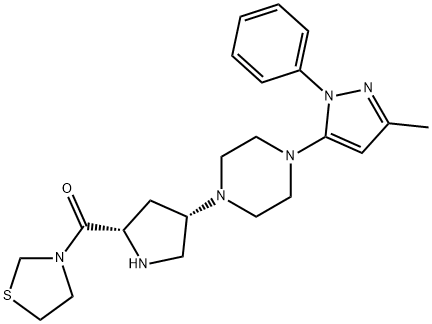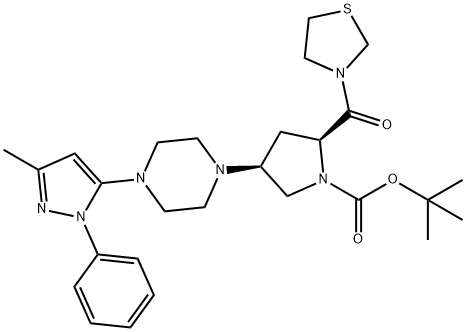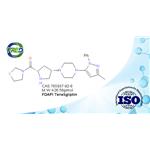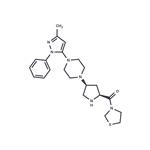Description
Teneligliptin was approved in September 2012 in Japan for the treatment of patients with Type 2 diabetes mellitus (T2DM). Teneligliptin is a member of the dipeptidyl peptidase 4 (DPP-4) inhibitor class of antidiabetes agents. DPP-4 is an enzyme that degrades GLP-1, a 30-amino acid peptide that is secreted in response to food intake. GLP-1 stimulates insulin secretion and inhibits glucagon secretion, which leads to lower levels of plasma glucose. Teneligliptin is one of a growing numbers of DPP-4 inhibitors to be approved worldwide. The discovery of teneligliptin was guided by structure-based design, with a key element being binding of the phenyl group in the S2 pocket, which not only increases potency for DPP-4, but also improves selectivity versus DPP-8 and DPP- 9. Teneligliptin is a potent inhibitor of DPP-4 in the enzyme inhibition assay (IC
50=0.37 nM).
Originator
Mitsubishi Tanabe Pharma (Japan)
Uses
Teneligliptin, is a dipeptidyl peptidase-4 (DPP-4) inhibitor that is used to treat type 2 diabetes. It is eliminated via excretion, and has a half-life of 24.2 hours in the human body.
Definition
ChEBI: Teneligliptin is an amino acid amide.
Pharmacokinetics
Reported evidence suggests that with teneligliptin 20 mg therapy, Tmax was 1 hour, and t1/2 was 18.9 hours. Maximum (89.7%) inhibition in plasma DPP-4 activity was noted within 2 hours and maintained >60% at 24 hours. Compared to the placebo, active plasma GLP-1 concentration was higher throughout the day and even 24 hours after administration of 20 mg of teneligliptin. Metabolism of teneligliptin was majorly mediated through CYP3A4, a cytochrome P450 isozyme, and flavin-containing monooxygenases (FMO1 and FMO3). A weak inhibitory activity of teneligliptin on CYP2D6, CYP3A4, and FMO was noted, while there was no inhibitory activity on CYP1A2, CYP2A6, CYP2B6, CYP2C8, CYP2C8/9, CYP2C19, and CYP2E1. There was no induction of expression of CYP1A2 or CYP3A4. Reported evidence suggests that teneligliptin is metabolized and eliminated via renal and hepatic routes. Approximately 34% of teneligliptin is excreted unchanged via the renal route, while 66% is metabolized and eliminated via the hepatic and renal routes[1].
Side effects
The DPP-4 molecule in teneligliptin reduces the risk of hypoglycemia, although it is possible. These are some of teneligliptin’s major and minor side effects:
Hypoglycemia
Headache
Upper respiratory tract infection
Gastrointestinal symptoms
Constipation
Fatigue
Kidney problems
Nasopharyngitis
Skin rashes
Itching
Loss of appetite
Abdominal pain
References
[1] Surendra Kumar Sharma. “Teneligliptin in management of type 2 diabetes mellitus.” Diabetes, Metabolic Syndrome and Obesity: Targets and Therapy 9 (2016): 251–60.




